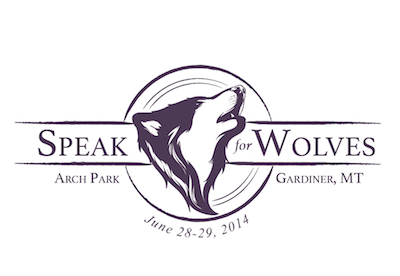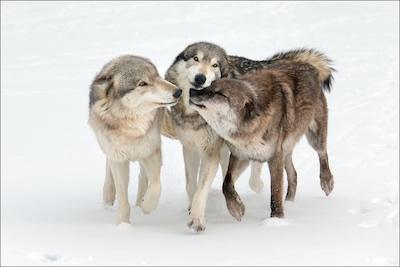
Editor's note: A rally to raise public awareness about wolves in and around Yellowstone National Park is scheduled for late June near the north entrance to the park at Gardiner, Montana. The following release came from the program's organizers.
The establishment of Yellowstone National Park in 1872 represents one of the greatest achievements in American history, affording protection to one of our country's true wild places. Appreciation for this action, and the land it preserved, is increasing with each passing generation. And Yellowstone is much more than an American treasure; it is an international jewel, attracting millions of people from all over the world every year.
Fast-forward 123 years to 1995 and 1996, when the federal government, at the behest of the American people, released 66 gray wolves into Yellowstone. After one of America's most iconic species was brought to near extinction through hunting, trapping, poisoning, and other government-funded methods in the 19th and 20th centuries, the U.S. Fish & Wildlife Service finally began to recover this internationally beloved species. And, because of its wildness and large size, as well as its complement of abundant prey species, Yellowstone was one of two places chosen to welcome the wolves home. Idaho was the second place.
On June 28-29, 2014, people of all walks of life are invited to attend Speak for Wolves: Yellowstone 2014, a 2-day family-friendly celebration of wolves, predators and other native species that contribute to our rich national heritage. The event will be held at Arch Park in Gardiner, MT, just north of the Roosevelt Arch, near the north entrance to Yellowstone National Park. Speak for Wolves: Yellowstone 2014 will feature prominent speakers and authors from the conservation community, and will include live music, education booths, children's activities and food vendors. The event is free and open to the public.
In addition to daytime activities at Arch Park, the screening of two wildlife documentaries will occur on Saturday evening, June 28, at 7 pm. The films will be shown at the Gardiner Community Center, which is located at 210 W. Main Street in downtown Gardiner. Organizers will be showing Predator Defense's film, Exposed: USDA's Secret War on Wildlife and Project Coyote's film, Coexisting with Wildlife: The Marin Livestock and Wildlife Protection Program. The films will be followed by a panel discussion composed of conservationists and scientists. The films are free.
Speak for Wolves: Yellowstone 2014 is an opportunity for the American people to unite and demand wildlife management reform, and to take an important step toward restoring our national heritage. Unbeknownst to many Americans, over 3,000 gray wolves have been slaughtered across America, including around Yellowstone National Park, since certain segments of the wolf population were prematurely stripped of federal protection under the Endangered Species Act just a few years ago. The controversial delisting of the northern Rockies gray wolf was the first time Congress intervened and delisted a species in the 40-year history of the Endangered Species Act.
A public rally is scheduled for late June to raise awareness about wolves/Monty SloanLengthy hunting seasons now occur in Idaho, Montana, Wyoming, Minnesota, Wisconsin, and Michigan. Hunters are permitted to hunt wolves with dogs in Wisconsin. Barbaric trapping/snaring seasons exist in Idaho. The USDA Wildlife Services just gunned-down 23 wolves from a helicopter in a rugged national forest in Idaho. In just 20 years, the federal government has completely reversed its course on the biological recovery of the gray wolf, and is now in the business of wiping them out again.
While many people are calling for relisting of gray wolves under the Endangered Species Act, others are saying that it is time to completely reform wildlife management in the United States.
Event organizers for Speak for Wolves: Yellowstone 2014 have developed the following five keys to reforming wildlife management in America:
* Ban trapping/snaring on all federal public lands.
* End grazing on all federal public lands.
* Abolish the predator-control department of the USDA Wildlife Services.
* Reform how state fish and game agencies operate.
* Introduce legislation to protect all predators, including wolves, from sport hunting, trapping, and snaring.
Please consider attending Speak for Wolves: Yellowstone 2014. The only thing that can save the gray wolf from a second extermination is a strong grassroots movement consisting of every-day people. Let's come together and embark on this journey together. Let's make the world a better place, for not only current generations, but also for those generations still to come. Your support is greatly appreciated! Learn more at www.speakforwolves.org or follow the event for updates at www.facebook.com/speakforwolvesyellowstone2014.




Comments
I HAVE gotten out and talked with ranchers from the Gardiner area. Five of them at the Town Cafe one morning last February. They were unanimous in their feeling that bringing wolves back to Yellowstone has been a good thing. They all said they had been opposed to the idea at first, but have changed their minds after seeing the benefits wolf watchers were bringing to the local economy. Only one of them has lost any cattle to a possible wolf kill. He acknowledged that the two calves he lost may have been killed by a pack of dogs allowed by their owner to run loose in the area. But even though there was doubt as to the killers of the calves, he was reimbursed for his loss by the Fish and Wildlife Service.
Instead of hiding behind anonymity, how about disclosing your reasons and interests in this debate. Are you ranchers? What are you? Where are you from?
We await your answers.
I dont have a particular dog in this fight but am amazed at the personal attacks vs reasoned argument. Perhaps Freedom was a little agressive with his "pimps" comment but the total disrespect for his arguments and interests is ironic coming from what is normally the "tolerance" crowd. If his stats in the opening post are accurate, then he makes quite a compelling case. If they aren't then demonstrate such rather then claiming "festering hate", "vile hatred" and questioning motives.
This has been an issue that's generated plenty of debate - and even more emotion - for years. Doesn't look like things have changed much. When topics such as this are involved, it can be difficult to find solid, and impartial, information from someone who, as ec says, doesn't have a dog in this fight.
Without citations, it's difficult to accept Freedom 1080s statistics. For instance:
* According to the National Park Service, Yellowstone is home to fewer than 200 moose. One of the reasons, though, is lack of suitable habitat.
http://www.nps.gov/yell/naturescience/mooseinfo.htm
* As for elk populations, Dr. Ralph Maughan, a professor emeritus of political science at Idaho State University with specialties in natural resource politics, notes that Wyoming's Game and Fish Department reported a near-record elk harvest last fall.
http://www.thewildlifenews.com/2014/03/26/wyoming-has-a-near-record-elk-...
At the same time, it's been well-noted that the park's Northern elk herd has declined quite a bit in recent years. But is it due to hunting, to wolves, to grizzlies, to brucellosis, to drought?
That said, Montana Fish, Wildlife and Parks officials went into last fall's elk hunt saying populations across the state were in good shape, with many areas (including southwestern Montana) reporting increased numbers.
http://fwp.mt.gov/news/newsReleases/hunting/nr_2015.html
Not to be overlooked is the debate over whether Yellowstone's wildlife is to be managed for hunter success or an ecologically balanced ecosystem.
Thank you, Kurt.
livingwithwolves- your posts were so incohearant and rambling I dont know how to really respond...As a historian, I tend to tune out the very second people start comparing the Third Reich and other issues. As for calling me 'bigoted' towards ranchers, I am not sure how you came up wit that conclusion. Perhaps you could explain more...
My 19th century mentality statement clearly went right over your head so I wont bother to respond to that...
I never said wolves were 'thriving' in the 19th century. I said that the wildlife in Yellowstone was living in a perfect balance of predator and prey prior to Europeans arriving. Clearly that one went over your head too...
When communicating in a written format, it might benefit you to work on your decoding and writing skills if you want your points to be understood by the otherside
And perhaps if you ranchers and farmers were not the most heavily subsidized groups in this country, people might be more receptive to your concerns.
For those who wonder why such strong reactions have come from some of the pro wolf killing folks just read the goals of the Speak for Wolves rally. This discussion is not about science or Yellowstone. It is about changing the culture of many of the rural areas of the country. It would be nice to think a reasonable balance could be reached on predator control and wildlife management in the US, but I can't think of single location where that has happened. Certainly not here in West Texas where I live.
I agree with Lee Dalton's plea for people to identify themselves. It is hard to argue with ghosts.
Wolves have a polarizing effect as people tend to be either for or against. I have read enough information that consistently states that when the top predators are on the landscape, the ecosystem is more resilient and healthy.
Accrording to MFWP, 80% of hunting units where wolves are present, elk populations are either exceeding or meeting goals. The majority of the units below goals are very close to meeting them. Wolves cannot afford to waste energy or become injured so they tend (not always) to prey on the old, lame, sick or very young elk. This results in a gene pool where the most healthy elk breed, reduces potential starvation and maintains healthy forage. They also keep elk moving thereby allowing aspen, willows and other vegetation to be restored.
Wolves account for less than 1% of livestock predation in the western US and actually help lower predation as they kill coyotes (main source of predation). Yes, wolves are no longer listed and can be hunted and trapped. Bald eagles and gray whales are no longer listed so should we start killing them. We know that predators keep nature in balance and its time to use this information instead of villifying them.